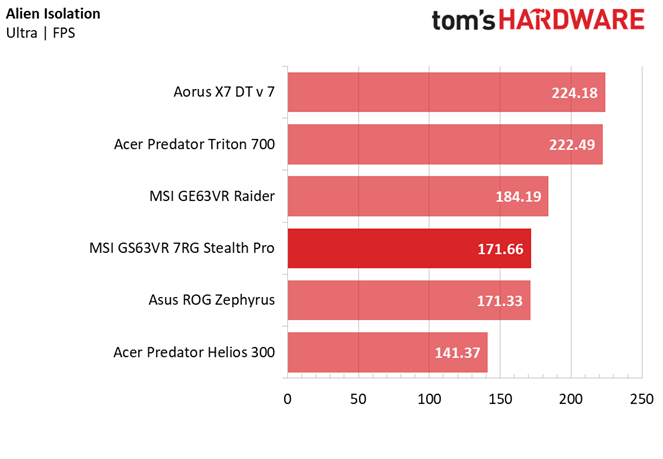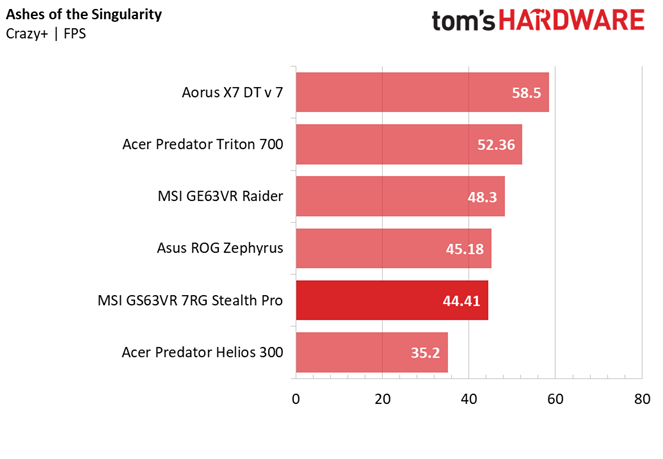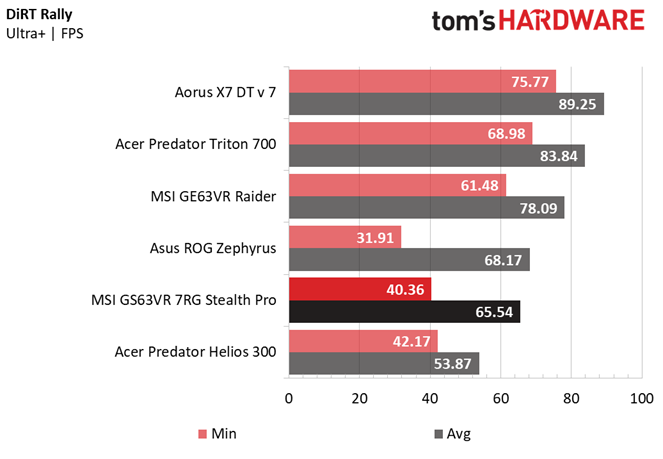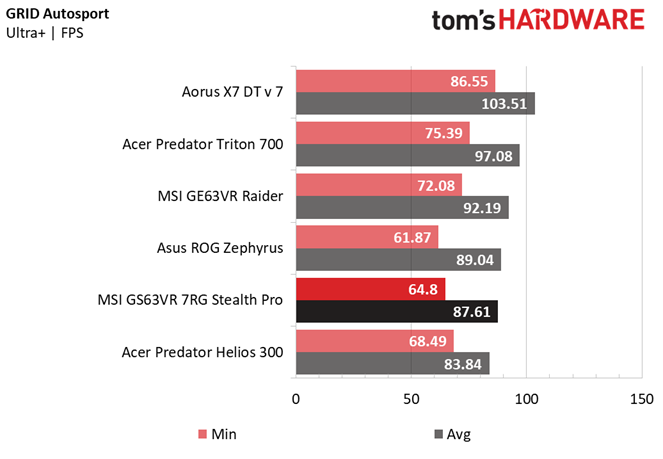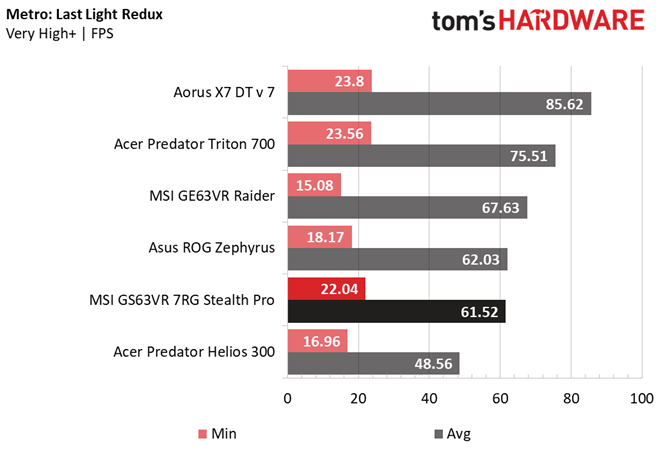MSI GS63VR 7RG Stealth Pro Gaming Laptop Review: Trim, Value-Minded Max-Q
Why you can trust Tom's Hardware
Gaming Benchmarks
In the course of our Max-Q reviews, we log the GPU’s average temperatures and clock rates to determine whether the system is experiencing thermal throttling. This will shed light as to whether the MSI GS63VR 7RG is running at full efficiency, particularly in GPU-reliant titles.
During our Asus ROG Zephyrus review, we used GPU-Z to log average temperatures and GPU clock rates to determine whether the GTX 1080 Max-Q was experiencing thermal throttling. We’ve included this again to shed light on whether this GTX 1070 Max-Q is running at full efficiency, particularly in GPU-reliant titles.
Alien: Isolation
We start off our gaming benchmarks with Alien: Isolation, which is the least taxing game in our suite. The MSI Stealth Pro provides ample performance, with an impressive 171 FPS, which matches the Zephyrus’s score. The Raider performs 7% faster thanks to its standard GTX 1070. However, additional GPU horsepower doesn’t amount to much once the 120Hz refresh rate is met. You can cut your costs in half with the Acer Predator Helios 300, but it doesn’t have the silky-smooth refresh rate that its higher-end competitors have.
Ashes of the Singularity
In Ashes of the Singularity, we see what we like to call a “staircase effect” in our charts, where a stronger GPU provides a marginally improved framerate. The Stealth Pro’s Max-Q GTX 1070 provides better performance than the Helios and its GTX 1060, but it cannot keep up with the Raider due to Max-Q’s power restrictions. The Max-Q GTX 1070 runs at 70° C and 1376MHz, meaning it’s running at near maximum efficiency.
The resulting performance difference is 4 FPS, or about 8% lower than the MSI Raider, bringing the Stealth Pro just below 45 FPS. This isn’t ideal but is serviceable when you lower the graphical settings. By comparison, the Helios runs about 10 FPS slower than the Stealth Pro and will require additional tweaking to reach higher frame rates.
DiRT Rally
DiRT Rally has a workload that most modern gaming laptops can handle. The Stealth Pro’s GTX 1070 Max-Q runs at near maximum efficiency, experiencing a temperature of 72° C and a boost clock of 1378MHz. The power restrictions pull the Stealth Pro 13 FPS below the Raider; luckily, the GTX 1070 Max-Q provides just enough performance to maintain over 60 FPS, on average.
Opting for the lower-end GTX 1060 doesn’t bode well for your frame rate; the Helios scores about 18 FPS lower than the Stealth Pro, driving the frame rate well below 60 FPS. Helios owners will have to reduce a few settings to reach 60 FPS, whereas the Stealth Pro delivers without compromise.
Get Tom's Hardware's best news and in-depth reviews, straight to your inbox.
Grand Theft Auto V
#ALBUM_32524
Grand Theft Auto V is a fairly intensive game, so you would think that a Max-Q GPU would run at full efficiency to keep up with the workload. However, when we previously reviewed the Eurocom Q5, we found the opposite to be true. The Stealth Pro exhibits similar behavior, with an average boost clock of 1363MHz, far below Nvidia’s max efficiency rating of 1379 MHz. The GTX 1070 maintained an average temperature of 70° C throughout.
The Stealth Pro doesn’t fall very far behind the Raider, either. We see less than 10% performance difference in most cases. Unfortunately, keeping pace with the Raider isn’t enough to maintain 60 FPS; even the Raider struggles to maintain 60 FPS in GTA V. You would need at least a Triton to maintain this threshold.
GRID Autosport
GRID Autosport’s platform based benchmark features a unique quirk: GPUs with high clock rates get an extra edge over the competition. This doesn’t mean a lower-end GPU will beat a higher-end one, but the competition will come dangerously close. In the past, we found that GTX 1060-equipped laptops give GTX 1070-equipped laptops a run for their money. The Helios sneaks up behind the Raider with a 10% performance gap.
This is worrisome for the Raider and its standard GTX 1070, and it certainly doesn’t sit well with the Stealth Pro. The GTX 1070 Max-Q is operating at 1377MHz in this scenario; try as it might, the Stealth Pro is only an arm’s reach away from the considerably cheaper Acer Helios.
Hitman
Hitman is only slightly more demanding than GRID Autosport, but without the clock-rate preference. Rather, it has a well-balanced workload. The Stealth Pro matches the Zephyrus and only comes a couple frames shy of the Raider. With this high of a frame rate, lowering the settings to reach 120Hz is worthwhile.
The Triton performs about 14% faster than the Stealth Pro, delivering just under 100 FPS. Meanwhile, the Aorus X7 outputs 106 FPS, bringing it well within the 120 FPS vicinity. The GTX 1070, Max-Q or otherwise, has quite a ways to go before reaching these frame rates. You’ll need at least a GTX 1080-based laptop to hit 120 FPS without a major visual impact.
Metro: Last Light Redux
Metro: Last Light Redux is where we raise the stakes; Metro is incredibly GPU reliant, requiring at least a GTX 1070 or equivalent GPU to maintain 60 FPS. The Stealth Pro’s Max-Q GTX 1070 runs at 73° C with a 1380MHz boost clock in this scenario, which is just enough for it to maintain 60 FPS. On the other hand, the Raider’s standard GTX 1070 comfortably surpasses 60 FPS with plenty of breathing room.
The Helios doesn’t fare as well. Its GTX 1060 pulls it below 50 FPS, meaning tweaks will be needed for a solid 60 FPS. On the opposite end, the Triton and Aorus X7 perform about 15 and 25 FPS faster, respectively, allowing them to take full advantage of their high refresh rates. The Stealth Pro will need graphical reductions for similar frame rates.
Rise of the Tomb Raider
Rise of the Tomb Raider raises the graphical bar a notch, and in turn increases the demand on your GPU. None of the laptops in this roundup, save the Aorus, is capable of maintaining at least 60 FPS here. The MSI Stealth Pro experiences a massive 10 FPS performance hit in comparison to the Raider's traditional GTX 1070, leaving it only about 5 frames faster than the Acer Helios. The Triton comes closer to 60 FPS, but it still falls behind by 5 frames. A graphically intense title like Rise of the Tomb Raider needs as much GPU power as possible, and reducing the power the GPU receives harms performance considerably.
The Division
The Division is yet another graphically intensive title, and we find a similar performance drop when comparing GPUs to their Max-Q equivalents. The MSI Stealth Pro loses over 10 FPS versus the MSI Raider, resulting in a 15% performance drop. Similarly, the Acer Triton performs 12% slower than the Aorus and its GTX 1080. Still, the GTX 1070 Max-Q provides ample performance, meeting the 60 FPS mark with frames to spare. The lower-end Acer Helios doesn't quite match up, scoring well below 60 FPS.
Thief
We end our gaming benchmarks with Thief, which has a workload similar to GRID's.
You won't need a high-end GPU to reach 60 FPS; a GTX 1060-based system like the Acer Helios is more than enough. However, the extra performance from a higher-end GPU would pull you closer to 120 FPS if you own a laptop like the Stealth Pro. It manages to reach 90 FPS without breaking a sweat, which is only about 3% less than the MSI Raider's frame rate. Lowering some of the settings will allow you to take advantage of the 120Hz refresh rate.
MORE: Best Gaming Laptops
MORE: Gaming Laptop Previews
MORE: All Laptop Content
Current page: Gaming Benchmarks
Prev Page Synthetic Benchmarks Next Page Battery, Thermal & Display Testing-
AgentLozen Thanks for the review. That display really leaves something to be desired.Reply
The Grand Theft Auto 5 gaming benchmark wasn't loading for me. I refreshed page and still no dice. -
justin.m.beauvais I'm thinking that this machine won't be that good for VR either. Primarily because the HDMI and USB 3.x ports are on opposite sides of the laptop, making it a pain to connect and route wires. Which is odd because VR would be a great way to get away from the sub-optimal display. Otherwise this seems a fine, if mediocre, entry into the Max-Q category. Nothing to really complain about, but little to stand out.Reply -
nibb0r I like me a laptop review, but I'll point out that it seems you have 7 pictures variously showing the plain old top of the laptop, and 0 that clearly show the left I/O all at once. Not a fan of the artsy angles and shallow depth of field.Reply
